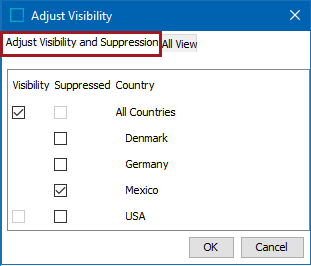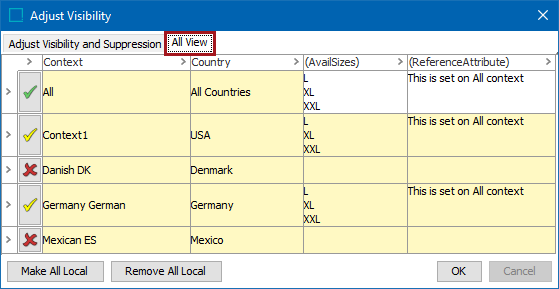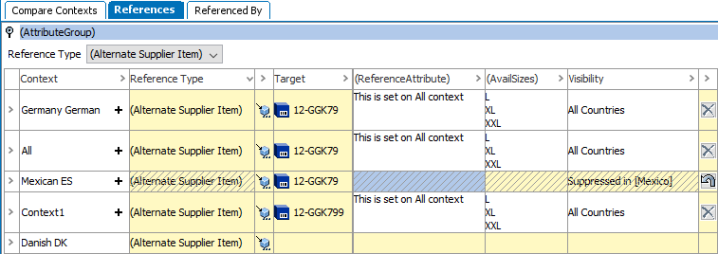On dimension dependent references and link types, you can specify the visibility of a reference or link in a specific context for display in the workbench (the Web UI is not effected). Based on the visibility, you can make a single setting and allow it to be inherited by other contexts, make local settings on some contexts, make all contexts have a local setting, or suppress the reference completely for a context.
- Making the visibility global means the reference settings are inherited from the global context. For example, when all contexts require the same setting.
- Making the visibility local means the reference does not inherit its settings from the global context. For example, if you want to define attributes on a language-by-language basis.
- Suppressing the visibility means it will not be used in a specific context.
Metadata attribute values are valid globally. However, when a reference is only visible in a local context, it is possible to have a description value that is only visible in that context as well.
Note: The Visibility column is displayed on a reference when the General Aspect option 'Visibility' is added to the 'Included in View' panel on the View Definition of the attribute group. For more information, refer to the Add a Metadata Attribute section of the Metadata Attributes on Reference and Link Types documentation here.
Setting Reference and Link Type Visibility
- In the Tree, select the relevant node, click the References tab, and open the flipper that contains the dimension-dependent reference to be edited.

- Double-click the Visibility field to display the ellipsis button (
 ), and then click the ellipsis button (
), and then click the ellipsis button ( ). The Adjust Visibility dialog displays with the 'Adjust Visibility and Suppression' tab active.
). The Adjust Visibility dialog displays with the 'Adjust Visibility and Suppression' tab active.

- In the Suppressed column, check any contexts that should not display the reference.
- Click the All View tab and note the status of the visibility of each context:
-
 indicates that the metadata attribute is local and not being inherited (All). The setting is inherited by the contexts that display a yellow check.
indicates that the metadata attribute is local and not being inherited (All). The setting is inherited by the contexts that display a yellow check. -
 indicates that the contexts inherits the settings of the context with the green check (USA and Germany).
indicates that the contexts inherits the settings of the context with the green check (USA and Germany). -
 indicates that the reference is suppressed (Mexico), or does not exist in the context (Denmark).
indicates that the reference is suppressed (Mexico), or does not exist in the context (Denmark).

- Modify the visibility of each required context as needed:
- Click
 or
or  to make the visibility of a reference local for only the selected context. Assuming the user has privileges to create the reference, the indicator changes to
to make the visibility of a reference local for only the selected context. Assuming the user has privileges to create the reference, the indicator changes to  , the reference value field changes to a white background, indicating that the setting can be modified on the selected context.
, the reference value field changes to a white background, indicating that the setting can be modified on the selected context. - Click
 to remove the local reference for only the selected context. The indicator changes to
to remove the local reference for only the selected context. The indicator changes to  , and inheritance is restored from the global context, and the reference value field changes to a yellow background, indicating that the setting cannot be modified on the selected context.
, and inheritance is restored from the global context, and the reference value field changes to a yellow background, indicating that the setting cannot be modified on the selected context.
- Click
 to make the visibility of the reference local for all contexts. In the 'Making all local' dialog, confirm that you want to make all local by clicking the Make Local button. All check marks turn green except the icon next to the contexts that were previously local (green). Previously local contexts are set with a red X, indicating that the reference no longer appears in those contexts. When the visibility of a reference is set to local, it no longer inherits its settings from the global context. This allows you to specify, for example, attribute values that only apply in the local context.
to make the visibility of the reference local for all contexts. In the 'Making all local' dialog, confirm that you want to make all local by clicking the Make Local button. All check marks turn green except the icon next to the contexts that were previously local (green). Previously local contexts are set with a red X, indicating that the reference no longer appears in those contexts. When the visibility of a reference is set to local, it no longer inherits its settings from the global context. This allows you to specify, for example, attribute values that only apply in the local context.

- Click
 to restore inheritance for all contexts currently local. In the 'Removing all local' dialog, confirm that you want to restore inheritance by clicking the Remove button. If a global context is local, all check marks turn yellow except the icon for the contexts that were previously local (green). Previously local contexts are set with a red X, indicating that the reference no longer appears in those contexts. When the visibility of a reference is set to global, it inherits its settings from the global context.
to restore inheritance for all contexts currently local. In the 'Removing all local' dialog, confirm that you want to restore inheritance by clicking the Remove button. If a global context is local, all check marks turn yellow except the icon for the contexts that were previously local (green). Previously local contexts are set with a red X, indicating that the reference no longer appears in those contexts. When the visibility of a reference is set to global, it inherits its settings from the global context.

- Verify the results of the visibility by checking the References page on the object and make any additional changes. Use the Context Mode by clicking
 in the toolbar.
in the toolbar.
Note: Navigate to View > Target to select the Contexts for the comparison view to display.

-
 indicates the reference is allowed for the context. Note that reference is not available for the Danish DK context in the image above.
indicates the reference is allowed for the context. Note that reference is not available for the Danish DK context in the image above. -
 indicates that the reference is local and values can be added for metadata.
indicates that the reference is local and values can be added for metadata. -
 indicates that the reference is inherited and values cannot be added for metadata.
indicates that the reference is inherited and values cannot be added for metadata. -
 indicates that the reference has been suppressed.
indicates that the reference has been suppressed. -
 allows you to remove the suppression for the selected context. In the 'Link deletion warning' dialog, confirm that you want to remove the suppression by clicking the Remove Suppression button. Previously set inheritance is restored. Return to the Adjust Visibility dialog to change visibility to local if necessary.
allows you to remove the suppression for the selected context. In the 'Link deletion warning' dialog, confirm that you want to remove the suppression by clicking the Remove Suppression button. Previously set inheritance is restored. Return to the Adjust Visibility dialog to change visibility to local if necessary.

-
 allows you to remove the current setting and suppress the reference for the selected context. In the 'Link deletion warning' dialog, confirm that you want to create a local suppression by clicking the Suppress button.
allows you to remove the current setting and suppress the reference for the selected context. In the 'Link deletion warning' dialog, confirm that you want to create a local suppression by clicking the Suppress button.
